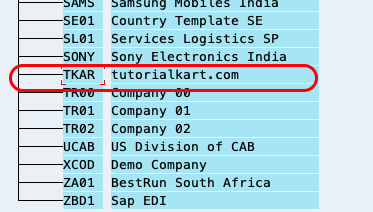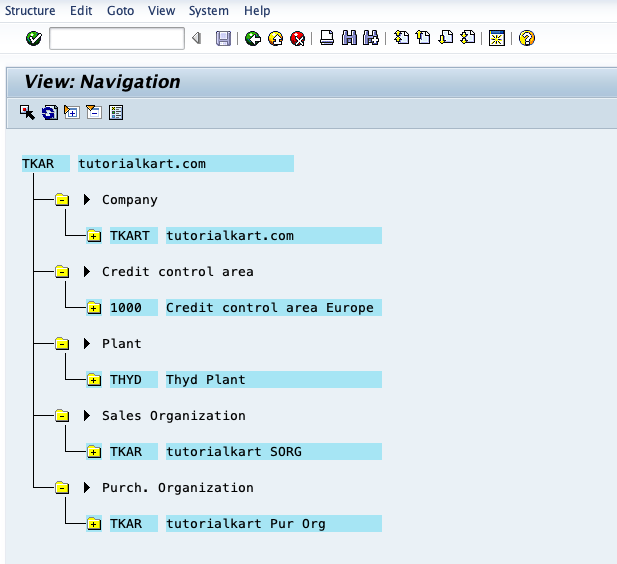The Enterprise Structure in SAP is the foundation of an organization’s operational and financial processes within the SAP system. It reflects a company’s hierarchical and functional setup, ensuring smooth integration of various business activities. Whether it is manufacturing, sales, finance, or inventory management, the Enterprise Structure provides a systematic representation of all organizational units. Let’s explore the various components of the SAP Enterprise Structure and understand their relevance.

1. Client
The client is the highest level of the organizational structure in SAP. It acts as a global entity, encompassing all data, configurations, and operations of the organization. In SAP, a client represents the enterprise as a whole, allowing for the segregation of data while still maintaining an overarching structure.
For instance, a multinational corporation like Tata Group can have one client for its global operations. This client will hold all the business data, and within it, specific configurations can be created for different business areas.
2. Company Code
The company code is a crucial part of SAP’s Enterprise Structure and represents a legally independent entity within the enterprise. It is responsible for maintaining all financial records, such as profit and loss statements and balance sheets. Each company code has its financial accounting, enabling the company to comply with statutory requirements.
For example, Tata Group might have multiple company codes such as Tata Motors, Tata Steel, and Tata Power. These codes ensure that financial statements for each entity can be independently prepared while still being linked under the same client.
3. Plant
A plant represents a physical or logical location where the organization’s operational activities occur. This includes manufacturing, warehousing, and distribution. In the SAP system, plants are critical for production planning, inventory management, and procurement.
For example: Royal Enfield may have plants in Tamil Nadu and Punjab for manufacturing its motorcycles. These plants will serve as operational hubs for production and stock management.
4. Storage Location
A storage location is a subdivision of a plant, allowing for detailed tracking of inventory within the plant. It represents specific areas where materials are stored, such as raw materials, finished goods, or packaging materials. This structure enables businesses to monitor stock levels accurately and ensure proper stock rotation.
For instance, a plant producing smartphones might have storage locations for raw materials like chips and screens, finished goods, and scrap materials.
5. Sales Organization
The sales organization is responsible for managing the sales, distribution, and service aspects of the business. It is the highest organizational unit in the SAP Sales and Distribution (SD) module and ensures that customer requirements are met efficiently.
For example, a company like Samsung might define different sales organizations for domestic and international markets to cater to their unique customer needs and regulatory requirements.
6. Distribution Channel
The distribution channel defines the pathways through which products or services reach the end customer. Common distribution channels include wholesale, retail, and direct-to-consumer sales. This classification allows companies to tailor their strategies for different customer groups.
For instance, a consumer goods company like Coca-Cola might use both retail outlets and direct bulk sales to restaurants as distribution channels.
7. Division
Divisions in SAP represent a grouping of similar products or services. They are used to segregate sales processes based on product lines, allowing businesses to better analyze the performance of each group.
For example, a company like Samsung might have divisions such as “Mobile Devices,” “Television and Audio,” and “Home Appliances,” each focusing on a specific product category.
8. Material Group
The material group is a further sub-division of the division and is used to categorize similar materials for better inventory and sales management. Within a division, products can be grouped based on their specific characteristics or usage.
For example, within the “Mobile Devices” division, the material groups could include smartphones, tablets, and smartwatches.
9. Sales Office
The sales office is the geographical representation of the company’s sales operations. It acts as a point of contact between the company and its customers in a specific region. Sales offices help businesses manage regional sales activities effectively.
For instance, a telecom company might establish sales offices in metropolitan areas like New York, Los Angeles, and Chicago to cater to regional customers.
10. Sales Group
A sales group is a team responsible for managing specific sales activities such as promotions, customer service, and payment collections. This ensures a focused approach to achieving sales targets and maintaining customer satisfaction.
For example, a software company might have a sales group dedicated to enterprise clients, managing everything from initial contact to after-sales support.
11. Credit Control Area
The credit control area manages customer credit limits and ensures financial stability by evaluating creditworthiness. It is critical for minimizing risks associated with defaults. The credit limit is determined based on the customer’s past payment history and transaction volumes.
For instance, a wholesale supplier might offer higher credit limits to customers with a strong track record of timely payments while restricting limits for new customers.
12. Controlling Area
The controlling area is used for cost management and profitability analysis within SAP. It provides a comprehensive view of costs and revenues across different business processes and ensures informed decision-making.
For example, a manufacturing company could use the controlling area to assess the cost of raw materials (CO-MM), overhead expenses (CO-PP), and promotional costs (CO-SD).
13. Shipping Point
The shipping point represents the location where goods are prepared for delivery. It plays a crucial role in managing inbound and outbound logistics. Shipping points ensure timely delivery of materials to customers or the receipt of materials from vendors.
For example, Amazon relies heavily on shipping points located in different regions to meet its fast delivery commitments.
14. Business Area
The business area is an internal organizational unit used for financial reporting and analysis. It allows businesses to evaluate profitability across different product lines, regions, or services.
For instance, a global organization might define business areas such as “North America,” “Europe,” and “Asia-Pacific” to analyze performance and make strategic decisions.
T Codes for defining Enterprise Structure in SAP
| Create Company Code | OX02 |
| Assign Company Code to Company | OX16 |
| Create Sales Organisation | OVX5 |
| Assign Sales Organisation to Company code | OVX3 |
| Create Distribution Channel | OVXI |
| Assign Distribution Channel to Sales Organisation (Sales Line) | OVXK |
| Create Division | OVXB |
| Assign Division to Sales Organisation | OVXA |
| Creating Sales Line (Sales Org + Distribution Channel) | OVXK |
| Creating Sales Area | OVXG |
| Create Sales Group | OVX4 |
| Creating Sales Office | OVX1 |
| Assigning Sales Group t0 Sales Office | OVXJ |
| Assigning Sales Office to Sales Area | OVXM |
| Creating Plant | OX10 |
| Creating Shipping Point | OVXD |
| Assigning Shipping point to Plant | OVXC |
| Assigning Plant to Company Code | OX18 |
How Enterprise Structure in SAP is Used
The Enterprise Structure in SAP is configured during the implementation phase to mirror the real-world organizational setup. This structure ensures smooth integration between various business processes like finance, logistics, and sales. It allows businesses to:
- Streamline Operations: Plants, storage locations, and shipping points optimize inventory and delivery management.
- Achieve Financial Transparency: Company codes and controlling areas provide clear financial reporting.
- Improve Customer Interaction: Sales organizations, offices, and groups enhance customer relationship management.
- Mitigate Risks: The credit control area safeguards against financial defaults.
Proper configuration of the enterprise structure ensures that businesses can scale effectively, maintain data accuracy, and generate insightful reports for decision-making.
How to view Enterprise Structure in SAP?
The Enterprise Structure in SAP represents an organization’s business units and divisions, serving as the backbone for financial management and reporting processes. It defines specific organizational units like company codes, plants, and sales organizations, ensuring streamlined operations and accurate reporting.
To view the Enterprise Structure:
- Use transaction code EC01.
- Alternatively, use /SAPPCE/ORG03 to display data via the object manager, selecting the project-oriented enterprise structure.
- Click on the Structure as shown below.

- Now click on Navigation.

Now to check the Enterprise Structure in SAP for our company code, select the Company code we need to click on f2 or choose button as shown below.


Now Enterprise Structure in SAP will be displayed as below.

At the top is the Client (TKAR), representing the overarching organization, which includes all associated data and configurations. Below it is the Company Code (tutorialkart.com), representing a legally independent financial entity for accounting and reporting.
Further down, the Credit Control Area (1000 – Credit control area Europe) defines the credit management policies for customers, ensuring financial risk is minimized. The Plant (THYD – Thyd Plant) signifies a physical or logical location where production, inventory, or distribution activities occur. Lastly, the Sales Organization (TKAR tutorialkart SORG) and Purchasing Organization (TKAR tutorialkart Pur Org) manage sales and procurement activities, ensuring seamless business processes.
